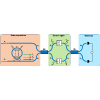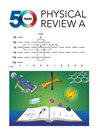使用双模挤压光的光学干涉仪用于增强芯片集成量子计量学
IF 2.9
2区 物理与天体物理
Q2 Physics and Astronomy
引用次数: 0
摘要
本文讨论了利用双模挤压光提高现有传感器技术性能的可能性,重点是在实际损耗条件下实现其微型化。因此,我们分析了一个由双模挤压光产生部分、传感器区域和检测阶段组成的系统。基于由三阶易感性引起的一般四波混合(FWM)哈密顿方程,我们提出了描述阈值以下 FWM 过程的线性化方程,并用于分析所产生的光信号和惰模的挤压质量。为了实现这一目标,我们将重点放在利用微栅谐振器进行芯片集成发电上。为此,在推导方程中考虑了设计和泵浦光的影响。这些方程用于分析双模挤压光在量子计量学中的应用以及在马赫-泽恩德干涉仪中的应用。由于损耗在实际应用案例中的影响,我们表明主要应用于小型和紧凑型设备,与仅使用相干光相比,量子改进可达 10 倍。这使得小型挤压增强传感器的性能可与大型经典传感器相媲美。本文章由计算机程序翻译,如有差异,请以英文原文为准。

Optical interferometer using two-mode squeezed light for enhanced chip-integrated quantum metrology
This paper discusses the possibility of using two-mode squeezed light to improve the performance of existing sensor technology with the focus on its miniaturization under realistic losses. Therefore, we analyze a system consisting of a part for two-mode squeezed light generation, a sensor region, and a detection stage. Based on a general four-wave mixing (FWM) Hamiltonian caused by third-order susceptibility, we formulate linearized equations that describe the FWM process below the threshold and are used to analyze the squeezing quality of the generated optical signal and idler modes. For a possible realization, the focus is set on chip-integrated generation using microring resonators. To do so, the impacts of the design and the pump light are considered in the derived equations. These equations are used to analyze the usage of two-mode squeezed light in quantum metrology and the application in a Mach-Zehnder interferometer. Due to the impact of losses in realistic use cases, we show that the main usage is for small and compact devices, which can lead to a quantum improvement of up to a factor of 10 in comparison with using coherent light only. This enables the use of small squeezing-enhanced sensors with a performance comparable to larger classical sensors.
求助全文
通过发布文献求助,成功后即可免费获取论文全文。
去求助
来源期刊

Physical Review A
物理-光学
CiteScore
5.40
自引率
24.10%
发文量
0
审稿时长
2.2 months
期刊介绍:
Physical Review A (PRA) publishes important developments in the rapidly evolving areas of atomic, molecular, and optical (AMO) physics, quantum information, and related fundamental concepts.
PRA covers atomic, molecular, and optical physics, foundations of quantum mechanics, and quantum information, including:
-Fundamental concepts
-Quantum information
-Atomic and molecular structure and dynamics; high-precision measurement
-Atomic and molecular collisions and interactions
-Atomic and molecular processes in external fields, including interactions with strong fields and short pulses
-Matter waves and collective properties of cold atoms and molecules
-Quantum optics, physics of lasers, nonlinear optics, and classical optics
 求助内容:
求助内容: 应助结果提醒方式:
应助结果提醒方式:


